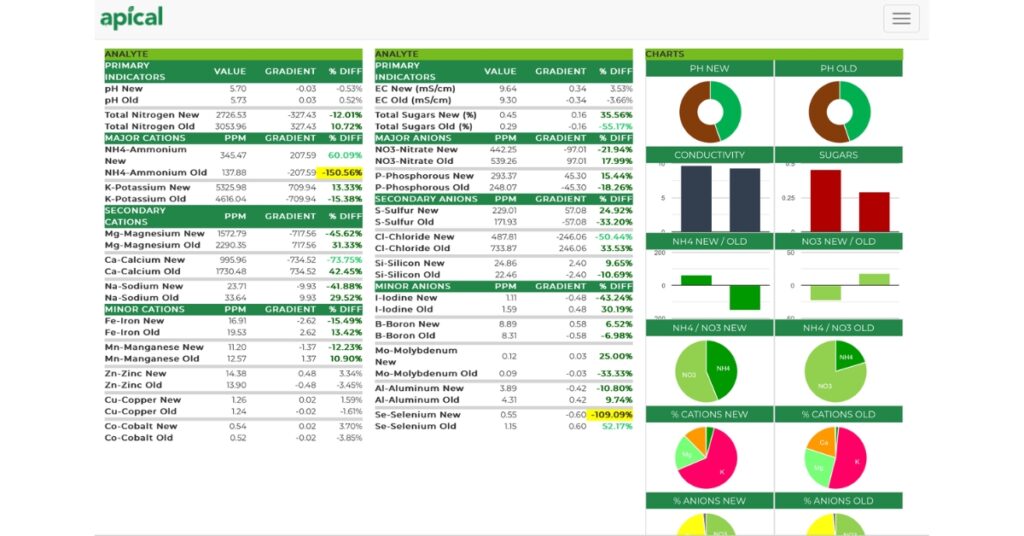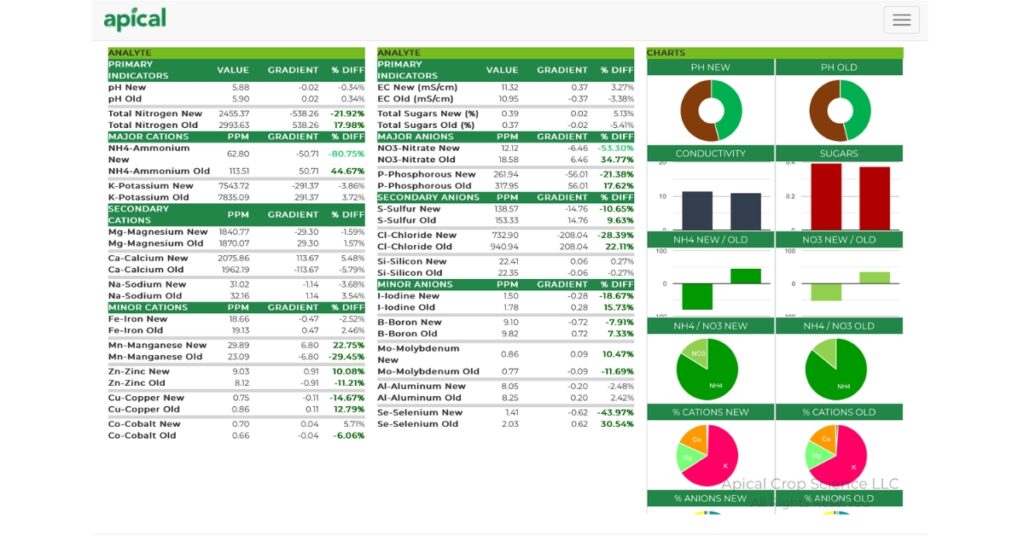Advantages and disadvantages of sap testing
Sap analysis is something we hear about more and more when discussing regenerative agriculture. I decided to dip my toes into the water around five years ago after listening to John Kempf’s Regenerative Agriculture Podcast.
As with any new technique, there was a learning curve when I sent my first samples to the lab. I found it easy to interpret the results for mobile nutrients like nitrogen, phosphorus, potassium and magnesium. Understanding the flow of mobile nutrients allowed me to accurately determine the plant’s needs; however, for immobile nutrients, I was forced relied on their database for determining sufficient levels.
I’ve attended conferences where David Knaus of Apical Crop Science spoke about the importance of percentages, ratios, and comparisons with antagonizing elements. His insights highlighted the multiple layers of information that sap analysis uncovers, surpassing the limitations of standard dry leaf analysis. The inclusion of various analytes in sap helps reveals these layers. Over time, I have become more comfortable interpreting the results and determining appropriate remedial actions.
Certain interactions I’ve observed include the relationship between chloride and phosphorus. When I can reduce chloride levels, I notice an increase in phosphorus levels. Thus, adding a carbon product to decrease chloride results in improved phosphorus uptake. Adding carbon offers additional benefits beyond this interaction, and it was a significant realization for me. I’ve also noticed a correlation between chloride ppm numbers and the occurrence of spider mite pressure.
Another interaction I’ve observed is between silica and aluminum. Although I haven’t reached the desirable ratios that David Knaus at Apical advocates, I have seen that improving the ratio translates to better crop health. Other analytes such as cobalt, molybdenum, iodine and selenium also play crucial roles in uncovering these layers. While I’m still exploring the numbers and ratios for optimum performance, I believe we are getting closer to finding the right balance as I examine more tissues.
The analysis results below illustrate how sap analysis allows us to look deeper into what is going on inside of our crops. This added insight becomes increasingly noticeable when comparing conventional and regenerative practices.

The first tissue sample, taken in May, represents a conventional almond orchard with typical grower inputs. We can observe the total nitrogen levels in relation to the ammonium and nitrate forms. This orchard has a history of hull rot disease, and based on the analysis, it appears that hull rot is likely to be present again this year. The high nitrate levels compared to ammoniacal nitrogen, along with poor conversion of inorganic N to plant-usable organic N, suggest a deficiency of molybdenum and carbon inputs as the probable cause. Additionally, the low calcium numbers pose a risk to the hulls’ cell structure during hull split, making them more susceptible to hull rot fungus. It’s also worth noting the potassium levels, as I have consistently observed higher K levels in regenerative systems compared to conventional ones.

The second tissue sample, also taken in May, represents a regeneratively farmed orchard transitioning to organic certification. In this sample, we can see a more efficient conversion of ammonium N and nitrate N to organic N. To aid nitrogen conversion, molybdenum, cobalt and carbon inputs have been added. The primary nitrogen source for this block has been a nitrogen-fixing bacteria, with two applications thus far. Additionally, the calcium-to-magnesium ratios are much better compared to the conventionally grown almond orchard.
So, why should you use sap analysis? Let’s consider the advantages and disadvantages:
Advantages:
1) Sap analysis is an excellent tool for monitoring mobile nutrition. When the numbers in old tissue decrease to less than 10 percent of the new readings, it indicates a draw and the need for possible inputs. By closely monitoring the movement of mobile nutrients like nitrogen, phosphorus, potassium, magnesium, sodium and chloride, we can forecast and address potential problems. Mobile trace elements, such as molybdenum, iodine and selenium, can also be monitored.
2) Sap analysis provides information on total nitrogen, as well as the amounts present in the ammonium and nitrate forms. This can give us invaluable insight into the efficiency of nitrogen metabolism in the plant.
3) More analytes are tested in sap analysis, allowing us to uncover additional layers of information as we gather more historical data. Apical offers a deluxe analyte that includes testing for nickel, lead, mercury, chromium, cadmium and more. I’m eager to use this deluxe version to troubleshoot challenging situations.
Disadvantages:
1) Sampling is restricted to specific times of the day. In regions with extreme temperatures, like Northern California, samples taken after 12 p.m. tend to dry too quickly.
2) To obtain representative results for both old and new growth, double the number of tissues need to be taken (although the lab charges for only one result).
3) Interpreting the results can be intimidating at first.
4) Data banks for desired ranges in sap analysis aren’t as extensive as those for dry leaf analysis. However, these data banks are rapidly expanding, and we have increased their size significantly in just the years I’ve been using sap analysis.
5) The inability to differentiate between the phosphite and phosphate molecules. This can lead to misleading phosphorus numbers when heavy use of phosphite applications are employed (dry leaf also will not separate the two forms).
Lastly, I want to discuss the immobile elements, including calcium, sulfur, boron, iron, zinc, manganese, copper, cobalt and silica. With sap analysis, we hope that the crop will extract these elements as needed. Again, I have observed better uptake of these immobile elements in regenerative agriculture practices compared to conventional systems.
Another immobile element that warrants close monitoring is aluminum. David Knaus recommends levels below 3 ppm, and although we still struggle to reach those numbers, we are steadily improving. As we enhance calcium, phosphorus, silica, cobalt and selenium levels, I believe our aluminum numbers will drop below 3 ppm. Ultimately, the level you aspire to achieve as a grower or crop consultant is a personal decision, but I believe sap tissues are necessary to reach the top shelf.
Jim Pingrey is an agronomic consultant in California’s Sacramento Valley.













